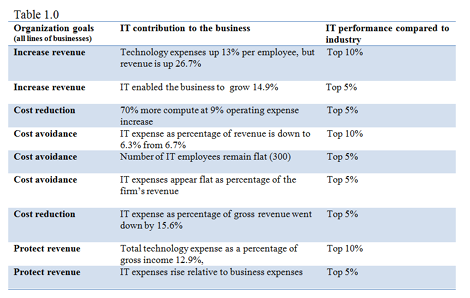Hani Elbeyali is a data center strategist for Dell. He has 18 years of IT experience and is the author of Business Demand Design methodology (B2D), which details how to align your business drivers with your IT strategy.
 HANI ELBEYALI
HANI ELBEYALIDell
Even when IT investments are showing positive business results, how could you prove beyond any doubt that this positive impact was attributed to IT investments? Maybe the improvement is due to external economic factors, shift in market demands or weak competition strategy. Not only measuring and reporting the benefits to the business is fundamental, but also how and what to measure are equally as important. These correct metrics will support your efforts in realizing and sustaining IT value.
IT is Core to the Organization
Reporting to management on IT should not mean using IT jargon. This doesn’t help IT and can be counterproductive because the unfamiliar language causes the IT department to be seen as an outsider to the organization's core.
Imagine that the CIO is walking into a board meeting, the head of the sales department reports on the execution strategy to meet the organization's financial target, while the CMO reports on the globalization strategy to reach new customers, and the CFO report the financial health of the organization. Now comes the CIO's turn to report on IT, and he/she starts by talking about the data center PUE ratio, the new ERP modernization project, the unified fabric offerings, and more abstractly, the cloud.
Immediately, everyone in the room puts their heads down, then looks at each other. There's confusion everywhere – no one understands what this jargon really means. They are asking, “How does any of that IT stuff enable them to perform their business and compete? Why the CIO is even here?" And so on. This type of communication cements the notion that IT is not core to the organization; that it's only supporting function. What exacerbates the issue is the attitude that if IT is not core to the organization, then, why not outsource it? Or out-task some functions at cheaper price, at minimum.
What to Measure and Communicate are the Real Issues
I certainly agree, showing IT's value to the enterprise is challenging. The problem is not the value IT creates, but what to measure and how to communicate this value. Current practices in IT performance measurement, metrics and reporting do not help, because they concentrate on reporting how IT spends money, rather than the value created from the spending.
Businesses usually measure success in monetary values, profits and losses, and attainable financial targets. Investments in IT are made only in initiatives yielding positive return on investment (ROI). In many cases, IT projects are long term, the ROI comes in long payback periods, which is not attractive proposition to the business. Charge back and re-allocation makes things worst, because each line of business argues why they are paying too much. As a result, to change the perception of IT into business driver, you must stop reporting on hardware and software performance, start reporting the contribution of IT to the success of the business.
What Happens If IT Impacts On Business Are Reported Correctly
To best demonstrate the technology attribution to the business, and what executives are expecting to see when reporting to management, take a look at the report example provided in table 1.0, this example report1 is for a mid-size organization. Keep in mind this report is for illustration only; the intent is to shows what important factors relating to report on to the business unites for the past quarter. Click to enlarge.
Click to enlarge.
Communicating IT Value
The report sample above speaks the same language of the business and it reflects IT attribution to the business the past quarter:
- IT expense as percentage of revenue and gross income for the quarter, 6.3%. The IT organization ranked top 10% when compared to the IT industry.
- The contribution of IT helped grew the business by 14.9% and drive 26.7% top line revenue, while keeping its operating expenses flat, The IT organization ranked top 10% when compared to the IT industry.
- The report shows evidence of the value strategic technology investment can add to the business performance, even in downturn economy.
- What is important to point out is the business continues to squeeze out and shrink the wrong operating expense—IT is only 6.3% of the firm’s revenue.
The business only wants to know the impact of the IT performance on revenue, cost and margin. It’s the job of the IT leader to act as a gateway and ensure communications are translated properly in both directions.
Please note the opinions expressed here are those of the author and do not reflect those of his employer.
Industry Perspectives is a content channel at Data Center Knowledge highlighting thought leadership in the data center arena. See our guidelines and submission process for information on participating. View previously published Industry Perspectives in our Knowledge Library.
1 This is an example report for illustration purposes only




